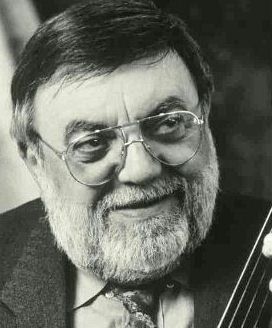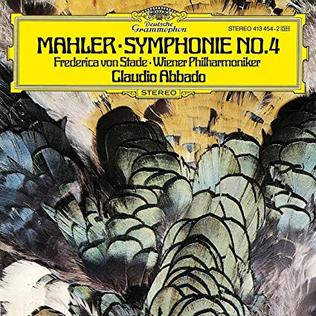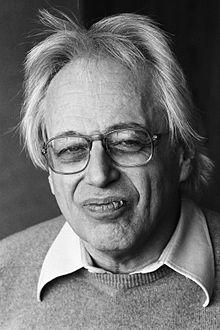Kontra-Punkte is a composition for ten instruments by Karlheinz Stockhausen which resolves contrasts among six instrumental timbres, as well as extremes of note values and dynamic levels, into a homogeneous ending texture. Stockhausen described it: "Counter-Points: a series of the most concealed and also the most conspicuous transformations and renewals—with no predictable end. The same thing is never heard twice. Yet there is a distinct feeling of never falling out of an unmistakable construction of the utmost homogeneity. An underlying force that holds things together—related proportions: a structure. Not the same Gestalten in a changing light. But rather this: various Gestalten in the same light, that permeates everything."
Kreuzspiel (Crossplay) is a composition by Karlheinz Stockhausen written for oboe, bass clarinet, piano and four percussionists in 1951. It is assigned the number 1/7 in the composer's catalogue of works.
Gruppen for three orchestras (1955–57) is amongst the best-known compositions of German composer Karlheinz Stockhausen, and is Work Number 6 in the composer's catalog of works. Gruppen is "a landmark in 20th-century music ... probably the first work of the post-war generation of composers in which technique and imagination combine on the highest level to produce an undisputable masterpiece".
Zsigmond Szathmáry is a Hungarian organist, pianist, composer, and conductor.
The Piano Concerto No. 1, Sz. 83, BB 91 of Béla Bartók was composed in 1926. Average playing time is between 23 and 24 minutes.

Siegfried Palm was a German cellist who is known worldwide for his interpretations of contemporary music. Many 20th-century composers like Kagel, Ligeti, Xenakis, Penderecki and Zimmermann wrote music for him. He was also Rektor of the Hochschule für Musik Köln and Intendant of the Deutsche Oper Berlin.
Adieufür Wolfgang Sebastian Meyer is a composition for wind quintet by Karlheinz Stockhausen composed in 1966. It is Number 21 in the composer's catalog of works, and the second of Stockhausen's three wind quintets, the others being Zeitmaße (1955-1956) and the Rotary Wind Quintet (1997).
Michael Vetter was a German composer, novelist, poet, performer, calligrapher, artist, and teacher.

Zeitmaße is a chamber-music work for five woodwinds composed in 1955–1956 by German composer Karlheinz Stockhausen; it is Number 5 in the composer's catalog. It is the first of three wind quintets written by Stockhausen, followed by Adieu für Wolfgang Sebastian Meyer (1966) and the Rotary Wind Quintet (1997), but is scored with cor anglais instead of the usual French horn of the standard quintet. Its title refers to the different ways that musical time is treated in the composition.
Formel (Formula) is a composition for chamber orchestra by Karlheinz Stockhausen, written while he was still a student in 1951. It is given the number 1⁄6 in his catalog of works, indicating that it is amongst the pieces preceding the composition he recognised as his first mature work, Nr. 1 Kontra-Punkte.
Schlagtrio is a chamber-music work for piano and two timpanists composed by Karlheinz Stockhausen in 1952. It is Nr. ⅓ in his catalogue of works.
Quatre Études de rythme is a set of four piano compositions by Olivier Messiaen, written in 1949 and 1950. A performance of them lasts between 15 and 20 minutes.

The Sonatine (Sonatina) for violin and piano is a chamber music composition by Karlheinz Stockhausen, written while he was still a student in 1951. It carries the work-number ⅛ in his catalogue of works.
Drei Lieder, for alto voice and chamber orchestra, is a song cycle by Karlheinz Stockhausen, written while he was still a conservatory student in 1950. In the composer's catalogue of works, it bears the number 1/10.
Spiel is a two-movement orchestral composition by Karlheinz Stockhausen, written in 1952. Withdrawn by the composer after its first performance, it was later revised and restored to his catalogue of works, where it bears the work-number ¼. The score is dedicated to the composer's first wife, Doris.
"Choral" (Chorale) is a short a cappella choral composition by Karlheinz Stockhausen, who wrote both the words and music in 1950. It was later given the number 1/9 in the composer's catalogue of works and lasts about four minutes in performance. The score is dedicated to the composer's first wife, Doris Stockhausen, née Andreae.

Stele, Op. 33, sometimes also stylised in Greek capitals as ΣΤΉΛΗ, is a composition for orchestra by Hungarian composer György Kurtág. It was completed in 1994.

Symphony No. 2, Op. 17, in A major by the Romanian composer George Enescu was written in 1912–14. A performance lasts about 55 minutes.

The Requiem by the Hungarian composer György Ligeti is a large-scale choral and orchestral composition, composed between 1963 and 1965.

The many recorded versions of Mahler's Symphony No. 4 include a 57-minute studio album that the operatic mezzo-soprano Frederica von Stade recorded with the Vienna Philharmonic Orchestra under the direction of Claudio Abbado. It was released in 1978.






